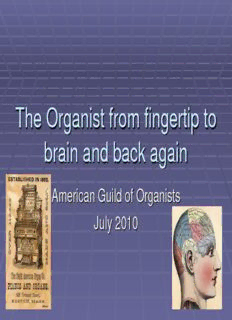
The Organist from fingertip to brain and back again PDF
Preview The Organist from fingertip to brain and back again
The Organist from fingertip to brain and back again American Guild of Organists July 2010 To create music Complex interplay between the sensory (visual, auditory, tactile, position sense), motor (output to peripheral muscles) and centers in the brain processing higher order, interpretive functions. These include language processing centers, executive function, ―limbic‖ emotional, memory centers, and cerebellar and basal ganglion input to promote orderly output and neuromuscular control Movement Movement is a complex sequence of events that begin with input from the sense organs in the hand, eyes and ears that travel up the afferent sensory nerves to terminals in the spinal cord In the Brain From there the nerve impulse travels up the sensory fibers to the receptor areas in the brain for touch, hearing and sight. They then pass through a complex series of inter-neuron switching systems that eventually connect to the motor cortex in the brain. 9+lv*=4GES The Visual System The Visual System Foveal regions of retina- sharp contrasts Retinal ganglion cells send axons to the cortex parallel pathways via optic nerve First stop lateral geniculate nucleus in the thalamus From there to visual cortex in the back of the brain Visual system-2 Temporal side of retina go ipsilateral brain. nasal side crosses over to the other side Left sided images goes to right side of the brain starting at the lat geniculate in different layers color, motion, form,contrast Orderly representation of the images, map, Visual system In the visual cortex (area 17) representation still orderly Projections to higher order visual areas to decode the info Parietal lobe where in space? Temporal lobe what does it mean? Decoding musical notes
Description: